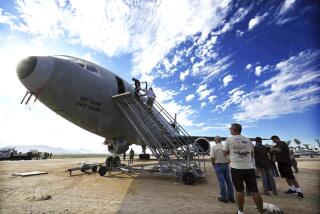NTSB Probes Aborted Takeoff’s Timing : USAir Pilot May Have Exceeded Jetliner’s ‘Point of No Return’
- Share via
NEW YORK — The captain of the jetliner that crashed here last Wednesday did not make the ill-fated attempt to abort his takeoff until the plane had neared or reached the speed at which it was too late to stop, a federal official said Saturday night.
“It appears he was very close to that speed,” James L. Kolstad, acting chairman of the National Transportation Safety Board, told reporters. “We are not sure whether he was a little above or a little below.”
That speed--known as “V1,” or the “point of no return”--varies according to the weight of the plane, the length of the runway and other factors.
It was up to Capt. Michael Martin and co-pilot Constantine Kleissas to calculate that speed and be aware of it as USAir Flight 5050 attempted to take off from La Guardia Airport last Wednesday night.
Questions Unanswered
For reasons that safety board investigators have yet to pinpoint, Martin’s attempt to abort the takeoff failed, and the Boeing 737-400 skidded off the end of the runway and into the East River, killing two women passengers.
But Kolstad’s report Saturday night suggested that Martin--who told investigators he decided to abort because he and Kleissas were unable to control the plane’s drift to the left--may have waited too long before cutting the throttles, applying the brakes and deploying the engine’s thrust reversers.
“Under certain catastrophic conditions (like a wing falling off) you could attempt to abort after V1,” Bob Benzon, the investigator in charge of the safety board probe said. “Otherwise, it’s not a good idea.”
Investigators said it may be months before a precise cause of the crash is determined, but attention has focused from the outset on reports of aberrant and inept behavior by the cockpit crew.
Kolstad has said there “clearly was a lack of proper procedure in the cockpit” of USAir Fight 5050 in the seconds before the crash, and in separate interviews with the safety board each pilot cast doubt on the other’s performance.
Piloting First Takeoff
Martin said Kleissas, who was piloting his first takeoff in a Boeing 737-400 on a regularly scheduled flight, showed “obvious” inexperience, inadvertently disengaging the plane’s automatic throttle mechanism as the jet began its takeoff roll down Runway 13-31.
Kleissas, who reportedly told law enforcement officials that Martin had been “acting irrationally” before takeoff, mentioned that the captain was “babbling” when going over the pre-flight checklist, although the co-pilot later said he regretted using that term.
Kolstad criticized both crewmen for waiting two days before taking blood and urine tests to determine whether they had been using drugs or alcohol. The results of those delayed tests have not been announced.
On Saturday, workers drained fuel and water from the wreckage to lighten the load before a second attempt is made to hoist the broken fuselage onto a barge.
The first attempt to lift the three large sections into which the jetliner fractured on impact was halted Friday because of deteriorating weather spawned by remnants of Hurricane Hugo and because the fuselage was found to be wedged against pier pilings.
The winds that had been whipping up a chop on the East River eased somewhat Saturday and New York Port Authority officials said a larger crane should be in place by this morning.
The safety board said it plans to take the wreckage by barge to a nearby airport hangar, where experts can begin examining the plane for further evidence of factors that may have contributed to the crash.
More to Read
Sign up for Essential California
The most important California stories and recommendations in your inbox every morning.
You may occasionally receive promotional content from the Los Angeles Times.













